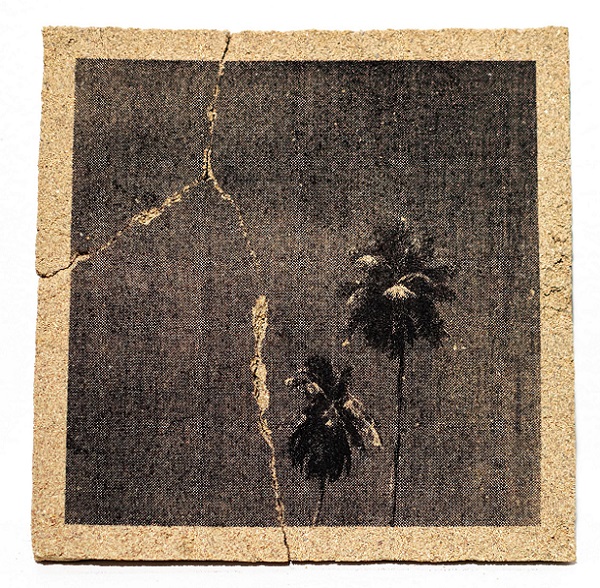
Sheila Ramírez (C& América Latina): “Mariana Ramos Ortiz is a Puerto Rican artist who explores sand as artistic material in her work reflecting on environmental fragility and the resistance to American occupation of the island. Her work also addresses the importance of preserving the earth through symbols such as the palm tree.”
C& América Latina: Talk to me about the process working with sand, a material for which collapse is so central to its anatomy.
Mariana Ramos Ortiz: I like thinking about what that kind of material implies in the Caribbean and what that kind of soil means contextually in Puerto Rico and, further, in the United States. Seeing how I can push certain materials to their limits and challenge interpretations of fragility. I had never thought of sand in the context of visual arts since it’s quite difficult to transport to exhibitions. My background is in printmaking, and printmaking here in the Caribbean is experimental. We have such a rich story of printmakers who have left and moved beyond the traditionality of the medium. I’ve been fascinated by the poetics of the material, thinking about engraving as repetition, as nuance and as the idea that things are identical. The printing process in sand is, actually, simple. You just have to think about how hydrated the sand is, how fine the grains are, how pressed the screen-printing sieve is, and to print in that sand, instead of ink, I use charcoal which is specifically prepared for that.
C&AL: Regarding the idea of the game as resistance, how is it related to the construction of new thought?
MRO: I think about the game as something that requires repetition, that has rules, but sometimes has no end. Time here is circular. The year is cyclical, it’s about returning to hurricane season and being aware of the body’s repetition and the thought associated with the idea of living in the colony, in the Caribbean, and facing the difficulties of being here. It’s like a game that doesn’t end. Maybe those are the negative parts that we could change about these spaces. Preparing for a hurricane or being without power for a period of time become central to the experience of life here and end up creating a cage when in reality, if we think about, there is no reason we should be going through that. Sand suggests the power of undoing that structure, like in the game of hopscotch, where you go round and round in circles, and toss a coin into the air that never falls as such because you cannot throw it circularly. Some people completely lose their sense of direction and simply find themselves in this circular path, and others see it as “a structure in which we are living, which is difficult to get out of, yet one that can be undone.”
This piece can be touched and felt, but there are other pieces that cannot be touched, and that is very important to me. The United States has been the place where I’ve had the most problems with people wanting to touch my work, and that makes me think that I am making a piece about the fragility of that space, specifically the idea of creating borders, and what happens if you, an American, who are complicit in much of these dynamics, touch this piece without caring, without thinking about or knowing what the implications are of living in that space. It becomes a microcosm of the Puerto Rican experience.
C&AL: The image of the palm tree in your work makes us think about the dynamics of protected land in Puerto Rico and about the fight to maintain those spaces intact for the island’s people. How do you process changes in the landscape?
MRO: The palm tree has many meanings here in Puerto Rico, and it has the ability to make us lose ourselves in it. It is an element I am exploring and seeing how it fits in relation to other things, but, yes, there is also the idea of documenting space and the landscape. I grew up on the coast and, for me, it’s an important place to think about those changes. Working with sand also evokes that aspect of the footprint, which makes us think about issues like erosion, high sea levels, and the mangrove as a protective barrier. I think that the experience of visiting Puerto Rico again has a unifying effect on us when we go away to study or leave for another reason. Taking that moment to see if the things we recognize, which were important to us, are still there. Things that have no importance until they are lost. [. . .]
For full article, see https://amlatina.contemporaryand.com/editorial/mariana-ramos-ortiz-sand-as-a-symbol-of-structural-fragility/
[Shown above: Mariana Ramos Ortiz, “Breezeblocks I,” sand, acrylic, 36″ x 60″ 2″; and “Ráfaga (Burst),” silkscreen on sand, 8″ x 8″ x .5″. Courtesy of the artist.]
Sheila Ramírez (C& América Latina): “Mariana Ramos Ortiz is a Puerto Rican artist who explores sand as artistic material in her work reflecting on environmental fragility and the resistance to American occupation of the island. Her work also addresses the importance of preserving the earth through symbols such as the palm tree.” C& América Latina:








